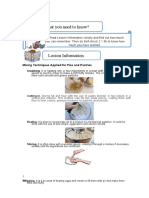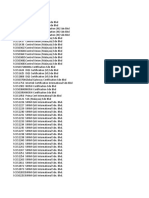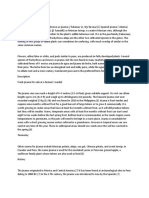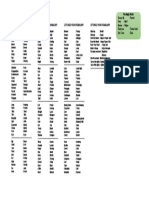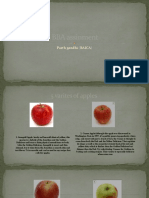Week 5: Prepare Baking Products
Week 5: Prepare Baking Products
Uploaded by
Rhoze ApiloCopyright:
Available Formats
Week 5: Prepare Baking Products
Week 5: Prepare Baking Products
Uploaded by
Rhoze ApiloOriginal Title
Copyright
Available Formats
Share this document
Did you find this document useful?
Is this content inappropriate?
Copyright:
Available Formats
Week 5: Prepare Baking Products
Week 5: Prepare Baking Products
Uploaded by
Rhoze ApiloCopyright:
Available Formats
WEEK LEARNING ACTIVITY SHEET IN BREAD AND PASTRY PRODUCTION SHS
PREPARE BAKING PRODUCTS
5
Learner’s Name: _ _ _
Grade Level/Section: ___
Date:
Parent Name and Signature:___________________________________________
I. INTRODUCTORY CONCEPT:
Leavening agents are gases that cause the dough to rise. In the presence of moisture,
heat and others, the leavening agent reacts to produce gas (often carbon dioxide) that becomes
trapped as bubbles within the dough. When a dough or butter is baked, it “sets” and the holes
left by the gas bubbles remain. This is what gives breads, cakes and other baked goods to rise
and increase in volume.
II. LEARNING COMPETENCY:
LO. Select, measure and weigh required ingredients according to recipe or
production requirements
LEARNING OBJECTIVES:
1. Differentiate the classification of leavening agents.
2. Identify the types chemical leaveners and biological leaveners
BREAD AND PASTRY PRODUCTION 1
LEARNING INFORMATION
LEAVENING AGENT
Leavening agents are gases that cause the dough to rise. In the presence of moisture, heat, and
others, the leavening agent reacts to produce gas (often carbon dioxide) that becomes trapped as
bubbles within the dough. When a dough or batter is baked, it "sets" and the holes left by the gas
bubbles remain. This is what gives breads, cakes, and other baked goods to rise and increase in
volume.
A. Classification of Leavening Agents
1. Chemical Leaveners. Chemical leaveners are chemical mixtures or compounds that release
gases, usually carbon dioxide. Chemical leaveners are used in quick breads and cakes, as well as
cookies.
Examples of chemical leaveners are
a. Baking Soda - otherwise known as bicarbonate of soda, or Sodium Bicarbonate. It is a chemical
salt with diverse practical uses. It is a powerful leavener that readily reacts as soon as it comes in
contact with batter or dough.
b. Baking Powder – is a combination of baking soda and acid salt.
c. Cream of tartar - is tartaric acid and is a fine white crystalline acid salt which is a by-product of
the wine-making industry. It is used in the whipping of egg whites to stabilize them and allow them to
reach maximum volume.
2. Biological Leaveners. Yeast is a living organism, neither plant nor animal. Yeasts belong to a
separate kingdom in taxonomy, the fungus kingdom. Leavening with yeast is a process based on
fermentation, the process of converting sugar to alcohol and to carbon dioxide.
Types of Yeast
Dry or Granular Yeast - provides ultimate baking activity in all yeast doughs, from low sugar to
highly sweetened breads.
Compressed - is a fresh cream yeast that has been drained from most of its water and
compressed into small blocks.
Instant Dry - is also known as “fast rising” or “fast acting”, can shorten the rising time in
traditional baking by as much as 50%. Suitable for recipes using traditional and bread machine
baking method.
3. Physical Leaveners
There are two types of physical leaveners: air and steam.
a. Air is often incorporated into batters when butter and sugar are creamed together. Briskly
whisking butter (or another solid fat) with sugar traps small pockets of air within the fat. Air
can also be used as a leavener when whipping egg whites or cream. In both instances,
the air becomes trapped within a protein matrix in the cream or egg whites, causing
expansion. On a smaller scale, sifting flour also traps a small amount of air and can offer a
minimal level of leavening action.
b. The second physical leavener is steam. When water converts to steam, the volume increases
by approximately 1,600 times its original size. When moist batters are introduced to high
temperatures, the liquid in the batter rapidly transforms into steam. The steam becomes
trapped within the batter, which solidifies as it is baked. Steam is used as a leavener in foods
such as popovers, cream puffs, and pie crusts.
BREAD AND PASTRY PRODUCTION 2
III. ACTIVITIES:
ACTIVITY 1 CLASSIFY ME!
Direction: Classify the leavening agents according to its type. Choose your answer from the
words listed below.
Air Baking Soda Active Dry Instant Dry
Steam Baking Powder Compressed
Chemical Leavening Agent Biological Leavening Agent( Yeast) Physical Leavening Agent
ACTIVITY 2 GUESS ME!
Direction: Fill in the blank by writing the correct answer from choices inside the box.
Instant Yeast Dry or Granular Cream of Tartar
Baking PowderBaking soda
1. The ___is also known as bicarbonate of soda, or sodium bicarbonate. It is a
chemical salt with diverse practical uses. It is a powerful leavener that readily reacts as soon
as it comes in contract with batter in dough.
2. The combination of baking soda and acid salt is ________.
3. The tartaric acid and is a fine white crystalline acid salt which is a by-product of wine-making
industry. It is used in the whipping of egg whites to stabilize them to allow them to reach volume
is __________.
4. The _______provides ultimate baking activity in all yeast doughs, from low sugar
to highly sweetened breads.
5. The _________is also known as “fast rising” or “fast acting”, can shorten the rising
time in traditional baking by as much as 50%. Suitable for recipes using traditional and bread
machine baking method.
ADDITIONAL ACTIVITY:
Watch a video about leavening agents. From the video you watch, write down the types
of leavening agents and its uses https://youtube.com/watch?v=ATvQWju8wj4&feature
CONGRATULATIONS!
You made it with flying colors. Good luck on the next lesson
BREAD AND PASTRY PRODUCTION 3
IV. REFLECTION:
Why should we do differentiation of the classification of leavening agents?
How do we Identify the types chemical leaveners and biological leaveners?
V. REFERENCES
SLM TECHNICAL-VOCATIONAL-Livelihood Home Economics Bread and Pastry Production Manual
Page 14
LAS DEVELOPMENT TEAM
JOCELYN B. BOBIER - Writer - San Isidro National High School
KATHERINE D. VALLADOLID - Content Editor - Tiwi Agro-Industrial School
JAIRAH JOY I. CHAVEZ - Language Editor - Tiwi Agro-Industrial School
NOE FRANCIS B. BELEN - Layout Editor - Tiwi Agro-Industrial School
JANE ST. REVILLA - Content Reviewer - School Division Office of Albay
BREAD AND PASTRY PRODUCTION 4
V. ANSWER KEY:
Activity 1 CLASSIFY ME!
Chemical Leavening Biological Leavening Agent( Yeast) Physical Leavening Agent
Agent
Baking Powder Active dry yeast Air
Baking Soda Instant dry yeast Steam
Compressed yeast
Activity 2 GUESS ME!
1. Baking soda 2. Baking powder 3. Cream of Tartar
4. Dry or Granular Yeast 5. Instant yeast
BREAD AND PASTRY PRODUCTION 5
You might also like
- The Subtle Art of Not Giving a F*ck: A Counterintuitive Approach to Living a Good LifeFrom EverandThe Subtle Art of Not Giving a F*ck: A Counterintuitive Approach to Living a Good LifeRating: 4 out of 5 stars4/5 (5939)
- The Gifts of Imperfection: Let Go of Who You Think You're Supposed to Be and Embrace Who You AreFrom EverandThe Gifts of Imperfection: Let Go of Who You Think You're Supposed to Be and Embrace Who You AreRating: 4 out of 5 stars4/5 (1107)
- Never Split the Difference: Negotiating As If Your Life Depended On ItFrom EverandNever Split the Difference: Negotiating As If Your Life Depended On ItRating: 4.5 out of 5 stars4.5/5 (887)
- Omnivore - 90 Day - Activity 2Document122 pagesOmnivore - 90 Day - Activity 2john100% (2)
- Hidden Figures: The American Dream and the Untold Story of the Black Women Mathematicians Who Helped Win the Space RaceFrom EverandHidden Figures: The American Dream and the Untold Story of the Black Women Mathematicians Who Helped Win the Space RaceRating: 4 out of 5 stars4/5 (925)
- Grit: The Power of Passion and PerseveranceFrom EverandGrit: The Power of Passion and PerseveranceRating: 4 out of 5 stars4/5 (598)
- Shoe Dog: A Memoir by the Creator of NikeFrom EverandShoe Dog: A Memoir by the Creator of NikeRating: 4.5 out of 5 stars4.5/5 (545)
- The Hard Thing About Hard Things: Building a Business When There Are No Easy AnswersFrom EverandThe Hard Thing About Hard Things: Building a Business When There Are No Easy AnswersRating: 4.5 out of 5 stars4.5/5 (353)
- Elon Musk: Tesla, SpaceX, and the Quest for a Fantastic FutureFrom EverandElon Musk: Tesla, SpaceX, and the Quest for a Fantastic FutureRating: 4.5 out of 5 stars4.5/5 (476)
- Her Body and Other Parties: StoriesFrom EverandHer Body and Other Parties: StoriesRating: 4 out of 5 stars4/5 (831)
- The Emperor of All Maladies: A Biography of CancerFrom EverandThe Emperor of All Maladies: A Biography of CancerRating: 4.5 out of 5 stars4.5/5 (274)
- The World Is Flat 3.0: A Brief History of the Twenty-first CenturyFrom EverandThe World Is Flat 3.0: A Brief History of the Twenty-first CenturyRating: 3.5 out of 5 stars3.5/5 (2272)
- The Yellow House: A Memoir (2019 National Book Award Winner)From EverandThe Yellow House: A Memoir (2019 National Book Award Winner)Rating: 4 out of 5 stars4/5 (99)
- The Little Book of Hygge: Danish Secrets to Happy LivingFrom EverandThe Little Book of Hygge: Danish Secrets to Happy LivingRating: 3.5 out of 5 stars3.5/5 (419)
- Devil in the Grove: Thurgood Marshall, the Groveland Boys, and the Dawn of a New AmericaFrom EverandDevil in the Grove: Thurgood Marshall, the Groveland Boys, and the Dawn of a New AmericaRating: 4.5 out of 5 stars4.5/5 (270)
- The Sympathizer: A Novel (Pulitzer Prize for Fiction)From EverandThe Sympathizer: A Novel (Pulitzer Prize for Fiction)Rating: 4.5 out of 5 stars4.5/5 (122)
- Team of Rivals: The Political Genius of Abraham LincolnFrom EverandTeam of Rivals: The Political Genius of Abraham LincolnRating: 4.5 out of 5 stars4.5/5 (235)
- A Heartbreaking Work Of Staggering Genius: A Memoir Based on a True StoryFrom EverandA Heartbreaking Work Of Staggering Genius: A Memoir Based on a True StoryRating: 3.5 out of 5 stars3.5/5 (232)
- On Fire: The (Burning) Case for a Green New DealFrom EverandOn Fire: The (Burning) Case for a Green New DealRating: 4 out of 5 stars4/5 (75)
- The Unwinding: An Inner History of the New AmericaFrom EverandThe Unwinding: An Inner History of the New AmericaRating: 4 out of 5 stars4/5 (45)
- Blackberry Breakfast CakeDocument5 pagesBlackberry Breakfast Cakereema sajinNo ratings yet
- BPP Module 7Document11 pagesBPP Module 7Rhoze ApiloNo ratings yet
- BPP Module 8Document13 pagesBPP Module 8Rhoze ApiloNo ratings yet
- BPP Module 4Document11 pagesBPP Module 4Rhoze ApiloNo ratings yet
- BPP Module 6Document13 pagesBPP Module 6Rhoze ApiloNo ratings yet
- BPP Module 5Document14 pagesBPP Module 5Rhoze ApiloNo ratings yet
- Module 4 Lesson 2Document4 pagesModule 4 Lesson 2Rhoze ApiloNo ratings yet
- Week 1: Prepare Bakery ProductsDocument5 pagesWeek 1: Prepare Bakery ProductsRhoze ApiloNo ratings yet
- Module 4 Lesson 3Document3 pagesModule 4 Lesson 3Rhoze ApiloNo ratings yet
- Lesson Plan 21ST CenturyDocument3 pagesLesson Plan 21ST CenturyRhoze ApiloNo ratings yet
- Miraculous Markets v1.0 PagesDocument16 pagesMiraculous Markets v1.0 PagesCheyenne-Blue PlötzNo ratings yet
- Kenwood BM450 Bread MakerDocument177 pagesKenwood BM450 Bread MakerDe Muze MarkNo ratings yet
- Recipes Queques ENGDocument99 pagesRecipes Queques ENGFerccg89 (Ferccg)80% (5)
- Syllabus FSM 7 StudocDocument5 pagesSyllabus FSM 7 Studocemalyn cortezNo ratings yet
- Mspo TraceDocument8 pagesMspo TraceIshakNo ratings yet
- All You Knead To Know About Perfect PierogiesDocument2 pagesAll You Knead To Know About Perfect PierogiesWayne PozaryckiNo ratings yet
- Life SemifreddoDocument3 pagesLife SemifreddoRnD KuekuNo ratings yet
- 5 Popular Foods in Middle EastDocument19 pages5 Popular Foods in Middle EastBrix HatakeNo ratings yet
- Latihan Soal Pas Ganjil Des 24Document11 pagesLatihan Soal Pas Ganjil Des 24nur indah fitriaNo ratings yet
- Meeting 1 Procedure TextDocument7 pagesMeeting 1 Procedure Textyusufa04eNo ratings yet
- Mazamorra Morada IngredientesDocument3 pagesMazamorra Morada IngredientesManrique RosyurNo ratings yet
- A Few / A Little / Much / Many / Some / Any / No / A Lot ofDocument2 pagesA Few / A Little / Much / Many / Some / Any / No / A Lot oflarryNo ratings yet
- Raah Mahajan IHR 2-23-22Document2 pagesRaah Mahajan IHR 2-23-22mahajanraahilNo ratings yet
- CSM Grocery Price List - 25-06-2024Document5 pagesCSM Grocery Price List - 25-06-2024Arjun VinodNo ratings yet
- Best Three Bean Salad Recipe - How To Make Three Bean SaladDocument1 pageBest Three Bean Salad Recipe - How To Make Three Bean Saladvita.kadileNo ratings yet
- BREADmaking Self CheckDocument20 pagesBREADmaking Self CheckMemry LaneNo ratings yet
- Rochester Summer Camps 2024Document15 pagesRochester Summer Camps 2024inforumdocsNo ratings yet
- Il Il Il Il Il Il F: Chi ChiDocument5 pagesIl Il Il Il Il Il F: Chi ChiTEYSHA RESHVENYA A/P SURESH MoeNo ratings yet
- Vata, Pitta, Kapha Food GuidelinesDocument1 pageVata, Pitta, Kapha Food Guidelinessteffi.a.brandtNo ratings yet
- SINGKAMASDocument2 pagesSINGKAMASDummy1 Account100% (1)
- Week 011-Serving and Clearing Food and Drinks PPTDocument14 pagesWeek 011-Serving and Clearing Food and Drinks PPTReyn MonsalesNo ratings yet
- The Ideal French Fry Is Golden Brown in ColorDocument31 pagesThe Ideal French Fry Is Golden Brown in ColorAarajita ParinNo ratings yet
- ca:en:manuals:tillreda Portable Induction Hob - AA 1856031 2Document52 pagesca:en:manuals:tillreda Portable Induction Hob - AA 1856031 2droopyboreNo ratings yet
- Tài Liệu Ôn Thi Cao Học Môn Tiếng AnhDocument25 pagesTài Liệu Ôn Thi Cao Học Môn Tiếng AnhbichnguyenNo ratings yet
- Lets Build Your VocabularyDocument1 pageLets Build Your VocabularyRusli HamzahNo ratings yet
- A Tuscan Cookbook Tuscan Recipes For True Tuscan Italian Cooking, 2nd EditionDocument82 pagesA Tuscan Cookbook Tuscan Recipes For True Tuscan Italian Cooking, 2nd EditionSladjana DraskovicNo ratings yet
- Nalla Kara Podi - Subbus KitchenDocument2 pagesNalla Kara Podi - Subbus Kitcheninstallationsap1100% (1)
- BBA Assinment: Parth Gandhi (BAICA)Document59 pagesBBA Assinment: Parth Gandhi (BAICA)Parth GandhiNo ratings yet














































